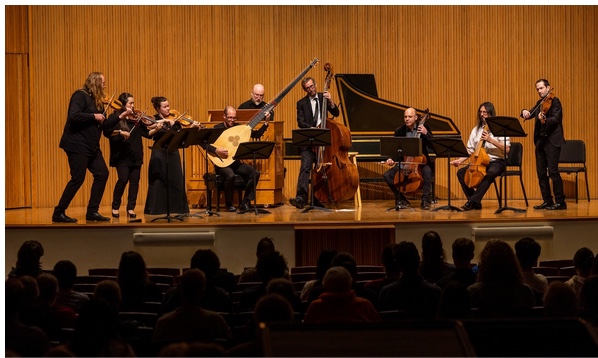by Stephanie Manning

The Oberlin Artist Recital Series proved the perfect occasion for the group’s visit to Northeast Ohio on November 15. ACRONYM was founded by Oberlin alumni, and their first public performance in 2014 was held in the same venue: Warner Concert Hall. They hadn’t been back since, making Tuesday’s concert a long-overdue homecoming.
Warner was a fitting choice not just symbolically, but also sonically. The combination of Baroque strings, theorbo, harpsichord, and organ created a nice blend and balance, allowing the opportunity for softer instruments to stand out. In Johann Rosenmüller’s Sonata à 5 in g, Doug Balliett’s violone pizzicatos resonated beautifully, and in Johann Heinrich Schmelzer’s Sonata in d, harpsichordist Elliot Figg became an equal player in the texture with his clever improvisations. The slight exception was Joshua Stauffer on theorbo — despite the instrument’s big physical presence on stage, he received little time in the spotlight.
Many pieces alternated between joyous dances and mournful laments, never staying in one mood for long. Violinist Edwin Huizinga spun a stunning cadenza above a rumbling, sustained organ chord in the opening Sonata jucunda, an anonymous work that has become one of ACRONYM’s signatures. In Antonio Bertali’s Sonata à 6 in d, the group dug into the unexpectedly crunchy harmonies, while in Giovanni Valentini’s Sonata in a, they made dramatic moments of silence just as meaningful as the repeated dotted rhythms. Throughout, the ensemble played together as if it was the most natural thing in the world, every entrance and cutoff perfectly in sync and every melody treated with care.
As well-rehearsed as they appeared, it could be easy to forget how much improvising is involved. As Balliett explained to the audience during a brief interlude, crafting music off of a barebones framework is a huge part of what these musicians do. That concept took center stage during Johann Pezel’s Ciacona à 6 in B-flat from Opus Musicum Sonatarum. The three violinists repeatedly traded off solos, each injecting their own personality — Huizinga sweet and lyrical, Cynthia Black intense and assertive, and Johanna Novom fiery and technical.
Two pieces with smaller instrumentations allowed more obvious communication across the ensemble. In Adam Drese’s Trio, Novom smoothly traded off melodies with Kivie Cahn-Lipman on tenor viol and Loren Ludwig on bass viol. Similarly, Andreas Oswald’s Quartet featured Huizinga, Ludwig, and violist Kyle Miller engaged in intense conversation, concluded by Balliett’s thundering descending scale.
Titled “Dreams of a Wounded Musketeer,” the program told the tale of an injured military trumpeter who spends his last moments reliving memories from his life in late-1600s Vienna. The program notes were creatively told from the musketeer’s point of view, but outside of that context, the musical choices didn’t quite produce a cohesive story. Some of this could be due to changes from the original format — the absence of violinist Adriane Post necessitated a number of piece substitutions while retaining the same composers.
Thankfully, the narrative saved the best for last with the piece that inspired the story in the first place: Heinrich Ignaz Franz von Biber’s Battalia. Huizinga encouraged listeners to “look out for cannons, drunken sailors, and beautiful little arias in the mix,” all of which were certainly delivered. This programmatic work featured some of the ensemble’s most ferocious playing, including percussive effects in the low strings representing the sound of cannons. After a resounding final chord, Balliett delivered the final shot with one last string snap — ending the wounded musketeer’s life for good.
Published on ClevelandClassical.com November 22, 2022.
Click here for a printable copy of this article



